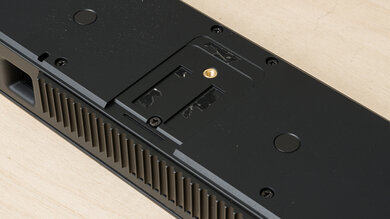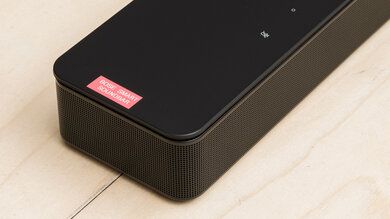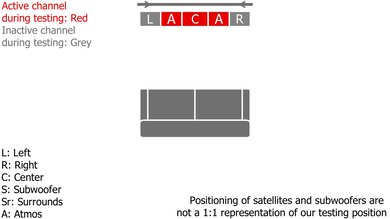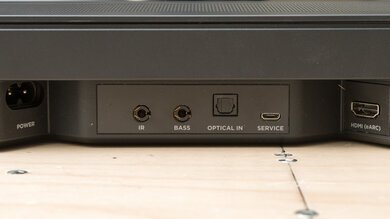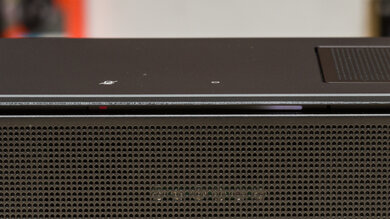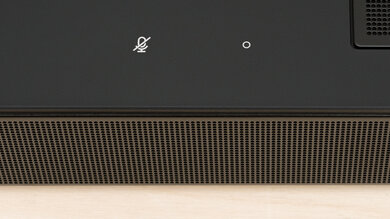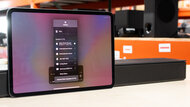The Bose Smart Soundbar is a compact all-in-one home theater solution, and it's the 2024 model update to the Bose Smart Soundbar 600. It carries on the TrueSpace technology from the last generation, which is meant to create an immersive sound, and it adds features like syncing the soundbar with your Bose Ultra Open Earbuds Truly Wireless for a personalized listening experience. If you're low on space but still want to experience the effect of Dolby Atmos, the bar might be the ticket. Let's check it out.
Our Verdict
The Bose Smart Soundbar is a decent pick for mixed usage. It's a small, low-latency bar compatible with Dolby Atmos and outputs your audio loud enough to fill a room while avoiding too much compression. It's mainly hindered by a lack of low-bass in its sound, which is a limitation determined by its size, but it outputs clear sound that's great for dialogue-heavy media, and you can adjust a few parameters like bass, treble, and height. While there's a lack of room calibration, the Wall EQ preset helps adjust the sound if you mount it. There's support for most wireless connections, and you can connect to older devices with Optical or use the eArc port. The absence of an HDMI In port means you can't use it as a hub for devices, though. Plus, without DTS support, it can't optimize the sound for all media either.
-
Wide soundstage for its small size.
-
Low latency.
-
Lots of wireless connectivity.
-
Retains dynamics well.
-
Lack of a subwoofer limits bass extension.
-
No DTS support.
-
No HDMI In.
-
No room calibration.
The Bose Smart Soundbar is satisfactory for dialogue and TV shows. Its center channel sounds balanced, so you can hear clear speech. Plus, it has an AI Dialogue mode to bring out more articulation for shows with busy mixes. It retains your audio's dynamics well, even at high volumes, too. However, if your shows are action-packed, it doesn't convey deep bass well because the bar's size inherently limits it from outputting a lot of low-bass.
-
Wide soundstage for its small size.
-
Low latency.
-
Balanced-sounding center channel and AI Dialogue mode.
-
Lack of a subwoofer limits bass extension.
-
No room calibration.
-
No 'Night' mode.
The Bose Smart Soundbar is decent for music. Its stereo soundstage is pretty wide, considering its compact size, thanks to the side-firing drivers, and it retains dynamics well so that music doesn't come across as overly compressed. Its frequency response has a good amount of punch and bright top-end, though it lacks the deep rumble of sub-bass synths and heavy low-end associated with EDM, hip-hop, and metal genres. Vocals and lead instruments sound more or less pretty balanced and articulate, though. It helps that you can connect wirelessly to Spotify, Wi-Fi, Bluetooth, and more, so it's not a hassle to throw on a song. The bass and treble adjustments add some additional control over the sound, too. Because TrueSpace is always on, there is a somewhat artificially wide quality to the overall mix.
-
Wide soundstage for its small size.
-
Lots of wireless connectivity.
-
Lack of a subwoofer limits bass extension.
-
No room calibration.
The Bose Smart Soundbar is satisfactory for movies. For its small size, it conveys a fairly wide passive stereo soundstage, while soundtracks and speech are clear sounding. However, it can sound a bit boomy due to the high-bass boost without the full low-end extension necessary to fully immerse you. Even at high volumes, it retains dynamics well. It's compatible with Dolby audio formats, but if you have a large Blu-ray collection, it lacks DTS. While there's not much in the way of user control, you get a couple of useful tools like bass and treble adjustment, and it handles Dolby Atmos content okay, which you can adjust the height of in the app. It's more of a jack-of-all-trades rather than a master of any, so surround audio sounds fine, though you can play around with the bass and treble.
-
Wide soundstage for its small size.
-
Low latency.
-
Retains dynamics well.
-
Lack of a subwoofer limits bass extension.
-
No DTS support.
-
No room calibration.
- 7.2 Mixed Usage
- 7.3 Dialogue/TV Shows
- 7.3 Music
- 7.0 Movies
Changelog
- Updated Nov 05, 2024: Review published.
- Updated Oct 31, 2024: Early access published.
- Updated Oct 21, 2024: Our testers have started testing this product.
- Updated Oct 11, 2024: The product has arrived in our lab, and our testers will start evaluating it soon.
- Updated Oct 04, 2024: We've purchased the product and are waiting for it to arrive in our lab.
Check Price
Differences Between Sizes And Variants
The Bose Smart Soundbar comes in one color, 'Black' and you can see our unit's label. If you find another variant of this soundbar, let us know in the comments, and we'll update our review.
Compared To Other Soundbars
Sitting a step above the slightly smaller and rather utilitarian Bose TV Speaker, the Bose Smart Soundbar adds Dolby Atmos support and higher max output volume, but if you're not interested in surround sound, they don't sound massively different in stereo. Compared to the previous Bose Smart Soundbar 600, the Smart Soundbar is quite similar in spec and performance, but if you have a pair of Bose Ultra Open Earbuds Truly Wireless, you can pair them with your Smart Soundbar for an enhanced surround experience. Still, it's not really a notable upgrade if you have the 600 already. That said, the Sonos Beam (Gen 2) is likely the most obvious competitor to the Smart Soundbar. Both are small bars, but the Sonos yields a bigger stereo soundstage, while the Bose has a better-sounding surround and more immersive Atmos implementation, and if you're in either brand's ecosystem, you gain access to a couple of extra features, too.
Check out the best all-in-one soundbars, the best small soundbars, and the best Dolby Atmos soundbars to see what else is available.
Whether you should choose the Sonos Beam (Gen 2) or the Bose Smart Soundbar depends on your primary usage and if you already own Sonos or Bose products to integrate under one app. The Sonos has a bigger stereo soundstage and works better for TV shows and music with a slightly better audio format support that includes DTS. Meanwhile, you may prefer the Bose for its better Dolby Atmos and surround sound and less compressed sound at high volumes.
The Sonos Arc is a larger and more premium all-in-one soundbar that is a bit better than the Bose Smart Soundbar for most people, unless you're short of space, though they share some of the same qualities, like a lack of full bass extension. The Sonos' stereo soundstage is bigger and sounds similarly balanced as the Bose, but you get room calibration and a 5.0.2 configuration as opposed to a 3.0.2. On the other hand, the Bose is smaller and keeps up well for Dolby Atmos and surround performance and falls only a bit shy on most other metrics, though it lacks DTS support.
The Bose Smart Soundbar is arguably almost the same as the Bose Smart Soundbar 600. They're the same size and sound very similar, with comparable performance. For most people whichever model you can find for less money is the better choice.
Whether the Klipsch Flexus Core 200 or the Bose Smart Soundbar is better is determined mainly by your habits. The Klipsch has a bit better stereo sound and soundstage, with more bass content out of the box. However, the Bose handles surround and Dolby Atmos content better with a more balanced and immersive sound. Plus, the Bose offers greater wireless connectivity allowing you to integrate it more easily for listening to music, whereas the Klipsch is limited to Bluetooth only.
Test Results
The Bose Smart Soundbar is an all-in-one soundbar that looks virtually identical to its predecessor, the Bose Smart Soundbar 600. It's plastic with a metal grill along the top and wrapped around the sides. Touch-sensitive controls are on the top, alongside a mic for voice control and an LED display.
It doesn't come with a subwoofer, but you can buy it bundled with the Bose Bass Module 500.
You can buy the soundbar as a standalone or bundled with the Bose Surround Speakers.
The soundbar is rather small and compact. It's low enough that it won't block your TV screen at the bottom and ought to fit between the legs of most TVs, like the 65-inch one pictured. It's the same dimensions as the previous Bose Smart Soundbar 600 and a mere three inches wider than the spartan Bose TV Speaker.
The soundbar sounds decent out of the box. The Bose TrueSpace function is always on, and it applies an effect that processes your audio so it sounds a bit bigger even when in stereo. Either end of the soundbar uses side-firing drivers to artificially expand the soundstage. By lacking an outboard subwoofer, there's not a full amount of low-end extension, so if you're listening to EDM or doom metal, that deep throb of bass and rumble isn't there. However, there's a good amount of punch on basslines, pretty clear vocals, and a crisp top-end. Mids are a bit uneven, but not so much as to obscure instruments. You can adjust the treble and bass, and there's a Wall EQ preset (which adjusts the sound for when the bar is mounted on a wall) in lieu of a room calibration.
You can adjust the bass and treble up to 10 steps in either direction of boost or cut, but there's not a full graphic EQ. The bass and treble adjustments are marked in increments of 10 from zero to 100. We calibrated the bar to '-30' for the bass and '30' for the treble. This brings out the mid-range a bit, so it's less overwhelmed by the boominess of the bass and adds more detail to the high-end.
The Bose Smart Soundbar has a decent stereo soundstage that extends wider than the bar, which is impressive considering its pint size, but it's somewhat artificially wide sounding. Bose's TrueSpace effect is always on and designed to make all audio sound wider. Side-firing drivers on each end of the soundbar are mainly responsible for widening the soundstage, though. The center channel is tasked with filling out the middle of the soundstage, which makes tracking parts a bit messier.
The Bose Smart Soundbar has very good stereo dynamics. Most of the compression present at max volume is in the lowest frequencies, which aren't as noticeable just because the soundbar doesn't output a lot of low-bass anyway. It gets loud enough to fill a big room.
The soundbar has a center channel with always-on up-firing drivers, and it sounds excellent. Speech sounds even and articulate, while there's enough low-end to sound full. That said, the bar's own limitation means it's not playing back the lowest bass, but for dialogue-heavy shows, it's great.
The soundbar has a passable surround sound performance. Like the Bose Smart Soundbar 600, it uses TrueSpace on all settings to add the dimension of height no matter what you're listening to. While it doesn't separate channels as cleanly as a home theater with satellites and a sub, it's not bad in a pinch or in a small space, but it definitely sounds warm and veiled in the details.
The Bose Smart Soundbar's Dolby Atmos performance is not bad, and it's perceived as about as wide as the bar's stereo soundstage. It's a little boomy with a very bright top-end. The mids sound pretty balanced for clear dialogue and soundtracks. The bar has two up-firing drivers for Atmos content and always uses the center channel as well. You can adjust the Atmos height in the app, but by default, sounds tend to land in front and above you, instead of around you.
Treble-like details have plenty of sheen, but action-packed scenes with low rumbles are out of reach for the soundbar's low-bass capabilities. Engine rumbles sound dull, lacking the immersion of deep bass with not a lot of easily trackable vertical movement. Side-to-side movements are more obvious and easier to track, but the Atmos effect doesn't envelop you. Nevertheless, it's a respectable effort for a small bar.
The soundbar is a bit barebones with regard to user control over the sound enhancement settings. You gain AI Dialogue Mode and Wall EQ. AI Dialogue adds a bit of treble to voices so they're clearer, and Wall EQ is a preset that alters the sound if you mount the bar. Otherwise, you can adjust the heights of the center channel and the bass and treble levels. There's no room calibration (which can be found on the Bose Smart Ultra Soundbar), and the TrueSpace function, which is advertised to inflate the size of the soundstage, can't be disabled. There's also no Night mode, but you can turn down the bass adjustment manually, which might offer some solace to your neighbors.
You can connect the soundbar via eARC or Optical. It has a subwoofer out that uses a 1/4-inch (3.5-mm) port. Otherwise, there's a micro-USB port for service and an IR port for an IR emitter. However, there's an absence of a full HDMI In port, and it can't act as a hub for video passthrough.
The soundbar supports Dolby audio formats and PCM, so you can listen to object-based audio mastered in Dolby Atmos, as well as the very common Dolby Digital iterations. Sadly, there's no DTS support, which means your Blu-ray collection won't necessarily shine in all its lossless glory.
The soundbar includes Dolby Digital and PCM support over Optical, so you can connect it to older devices.
This soundbar has low latency over eARC. With most audio formats, there's a low enough latency that you won't experience lag. There's more lag on Dolby Digital Plus and Dolby Digital Plus Atmos, but it's still quite low, so dialogue still matches up. However, you can use the companion app's A/V Sync function to compensate manually if the lag is noticeable in your setup.
The soundbar's Optical latency is good. It's still high enough that you'll notice a lip-sync mismatch, but you won't need to compensate as much through the app's A/V Sync. Some TVs handle latency differently, so your results may differ.
The Bose Smart Soundbar supports a huge array of wireless audio connections. You can use the app to group it together with other Bose speakers, and if you have the Bose Ultra Open Earbuds Truly Wireless, you can use those at the same time, too. It's at home handling your Spotify, Bluetooth, Wi-Fi connections, and more.
The remote control is small and plasticky. It covers basics well, like volume, playback, power, Bluetooth pairing, and inputs. The Bose Music app provides much greater control over the soundbar.
Alexa is built into the bar, and you can control it using the Bose Music app. Google's Chromecast requires you to set it up using your device and a Google Assistant-enabled device for voice assistance.




